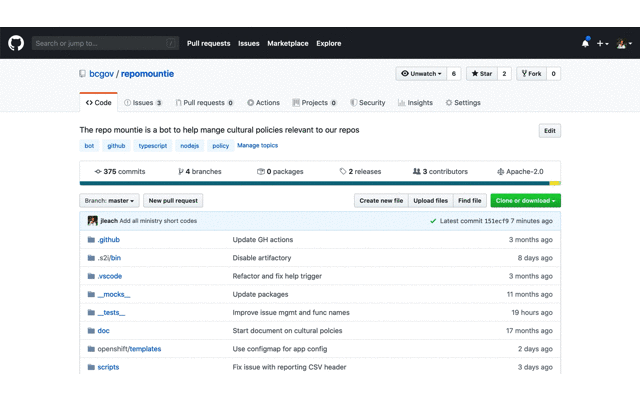A Reusable Helm chart for Patroni (Highly-Available PostgreSQL database), with a default configuration adapted to deployment on the BC Government's OpenShift cluster.
To learn more about the Common Services available visit the Common Services Showcase page.
.github/ - PR and Issue templates
charts/ - Helm chart root
└── patroni/ - Patroni Helm chart root
├── templates/ - Patroni template objects
├── Chart.yaml - Patroni Chart definition
└── values.yaml - Patroni Chart default values
CODE-OF-CONDUCT.md - Code of Conduct
COMPLIANCE.yaml - BCGov PIA/STRA compliance status
CONTRIBUTING.md - Contributing Guidelines
LICENSE - License
SECURITY.md - Security Policy and Reporting- Add Patroni as a dependency in your
Chart.yaml
dependencies:
- name: patroni
version: 0.0.4
repository: https://bcgov.github.io/nr-patroni-chart
# by default, the object created will be named <your-app>-patroni. You can use an alias to override the -patroni suffix
# Example "alias: postgres" would have "postgres" as the suffix instead.- Update your application (don't forget to update your helm dependencies with
helm dep up)
If this is your first time using helm, check out the quickstart guide. The steps below are similar to the one from the quickstart guide, but specifically for this chart
- Add Patroni Chart repository to Helm
$ helm repo add patroni-chart https://bcgov.github.io/nr-patroni-chartOnce the repo is added, you can check the available charts with:
$ helm search repo patroni-chart
NAME CHART VERSION APP VERSION DESCRIPTION
patroni-chart/patroni 0.1.0 2.0.1-12.4-latest Highly available elephant herd: HA PostgreSQL c...- Install an instance of the chart with:
$ helm install -n my-namespace my-patroni-instance patroni-chart/patroni
NAME: my-patroni-instance
LAST DEPLOYED: Mon Feb 28 15:38:32 2022
NAMESPACE: my-namespace
STATUS: deployed
REVISION: 1You can find an exhaustive list of the configurable settings in charts/patroni/values.yaml.
This chart creates two services, allowing to access the leader (read/write connection) and replica (read-only connection) pods, respectively. The postgres user's password is available in the secret created by this chart under the superuser-password key. Note that you should only use the postgres user to create the user that will actually be used by your application, as applications should not use superusers.
To report bugs/issues/features requests, please file an issue.
If you would like to contribute, please see our contributing guidelines.
Please note that this project is released with a Contributor Code of Conduct. By participating in this project you agree to abide by its terms.
Copyright 2022 Province of British Columbia
Licensed under the Apache License, Version 2.0 (the "License");
you may not use this file except in compliance with the License.
You may obtain a copy of the License at
http://www.apache.org/licenses/LICENSE-2.0
Unless required by applicable law or agreed to in writing, software
distributed under the License is distributed on an "AS IS" BASIS,
WITHOUT WARRANTIES OR CONDITIONS OF ANY KIND, either express or implied.
See the License for the specific language governing permissions and
limitations under the License.


